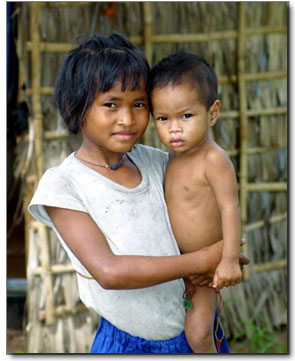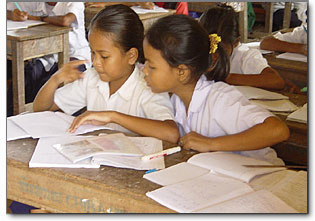Demographics
 Cambodia
is an ethnically homogenous country: 90 percent of its population
is Khmer. The remainder is comprised primarily of Vietnamese
and Chinese. There are a small number of hill tribes - Chams
and Burmese. Many Vietnamese were repatriated (that is, sent
back to Vietnam) during the early 1970s, thereby making the
population even less diverse. Cambodia
is an ethnically homogenous country: 90 percent of its population
is Khmer. The remainder is comprised primarily of Vietnamese
and Chinese. There are a small number of hill tribes - Chams
and Burmese. Many Vietnamese were repatriated (that is, sent
back to Vietnam) during the early 1970s, thereby making the
population even less diverse.
The
estimated population in 2003 was 13,124,764. Both the growth
rate (2.3%) and infant mortality rates are high, and the ravages
of the AIDs epidemic are likely to adversely impact the demographic
statistics of this country (Demographics of Cambodia, 2005).
Its population density is much lower in comparison to its
neighbors, Vietnam and Thailand. Most Cambodians live in
the central plains; the malaria infested and thinly watered
highland areas are sparsely settled. The impact of years
of war and civil unrest has resulted in 25% of households
headed by women. More than half its population is under age
18, and 58% of Cambodians over age 18 are women (Demographics
of Cambodia, 2005).
The Khmer Rouge depopulated many of Cambodia’s
towns and forced people into rural areas. Re-urbanization
began to take place in the early 1980s.
(Royal
Government of Cambodia, 2004; Demographics
of Cambodia, 2005).
Language
Approximately 95% of Cambodians speak Khmer. {LINK}Older
Cambodians speak French—a legacy of the French colonial era.
Younger Cambodians are likely to speak English as a second
language (Demographics
of Cambodia, 2005).
Health
Many Cambodians believe that imbalance, caused by natural
forces or changes in the environment, may cause illness. Some
may also believe that illness can have spiritual causes, and
they may deal with illness through traditional medicine and
self-medication, often using more than one treatment for the
same problem (This has been observed by the project fellows).
According to Wetzel, “herbal remedies, dermal techniques,
‘hot-cold’ balances and rituals” are all traditional techniques.
Cupping
(placing a candle on the forehead and covering it with a small
jar to create bruises) (Bentley, n.d.), and coining
(placing hot coins on the neck, forehead, chest) (Dinulos
& Graham, 1999) pinching or rubbing or kos khyal are
all examples of dermal techniques. These techniques may be
used to treat any number of common ailments such as fever,
cold, diarrhea, etc. For example, according to Wetzel, “the
hot-cold balance theory, illness is caused by a change in
the natural balance between hot and cold elements in the universe.
The patient adjusts drugs, herbs and food to restore balance
and harmony. If these remedies are not effective, Cambodians
will seek help from a traditional healer” (Wetzel,
2002). Some Cambodians also believe illnesses may be caused
by evil spells cast by others or mistakes made in rituals.
Spiritual healers may be called upon to heal this form of
sickness (Ready, 2002).
In Cambodia, traditionally family planning appears to be
uncommon. Elders or a midwife are called during labor and
delivery. The first month postpartum, women lie on a bed with
a fire under it. They eat a particular diet while other women
care for the baby. Most women breast-feed their babies and
may start them on rice soup as early as six weeks. However,
in the cities and in America, Cambodian women report that
the custom of nursing the babies is changing. Cambodian woman
are reported to be very modest and may have a tendency to
avoid annual gynecological examinations because they involve
pelvic and breast exams (Wetzel, 2002).
Wetzel (2002) reports that Cambodian refugees often may suffer
from depression and posttraumatic stress syndrome. There
is no comparable term for such ailments in Khmer, and so many
may not understand from what they are suffering. In addition,
many avoid prescribed drugs. They fear becoming addicted or
never awakening. According to the same author, Cambodians
may also fear blood draws, x-rays, and surgery. They believe
that when blood is drawn, it will weaken their body, because
it is not replaced. Surgery is viewed as the last resort.
Cambodians are often stoic when in pain.

Educational
System
The Khmer Rouge destroyed the educational system of Cambodia
during their rule. It has been rebuilt in the contemporary
Kingdom of Cambodia. The majority of Cambodians living in
the United States are the descendents of refugees and, therefore,
are the product of the traditional rather than the product
of the current Cambodian educational system.
Pre-1975 Cambodian Educational System
 The
parents and grandparents of Cambodian students in the United
States today are likely to be familiar with the education
system that existed prior to the Khmer Rouge takeover. During
the French protectorate, an educational system was created
that was based on the French model. This system remained in
place until 1975 and included primary, secondary, higher,
and specialized levels. The primary level was split into two
cycles each lasting three years. French was taught beginning
in the second year. Although Khmer was the language of instruction
in the first cycle, French was the language of instruction
from the second cycle and beyond (Coutsoukis, 2004). The
parents and grandparents of Cambodian students in the United
States today are likely to be familiar with the education
system that existed prior to the Khmer Rouge takeover. During
the French protectorate, an educational system was created
that was based on the French model. This system remained in
place until 1975 and included primary, secondary, higher,
and specialized levels. The primary level was split into two
cycles each lasting three years. French was taught beginning
in the second year. Although Khmer was the language of instruction
in the first cycle, French was the language of instruction
from the second cycle and beyond (Coutsoukis, 2004).
Similarly, secondary education included two cycles, the first
cycle lasted four years, and the second lasted three years.
When the first cycle was completed, students were required
to take an examination. Upon passing the examination, candidates
received a secondary diploma. When the first two years of
the second cycle were completed, students took a state examination
to earn a first baccalaureate, and, at the end of their final
year, a similar examination could be taken for the second
baccalaureate. The Cambodian secondary curriculum was based
on the French system (Coutsoukis, 2004).
There were several universities in Cambodia with enrollments
of over 9,000 students before the Khmer Rouge takeover by
the (U. S. Library of Congress, 1987). The University of
Phnom Penh was the largest with 4,570 male students and 730
female students in eight departments. There was also a university
for agricultural sciences and fine arts (Coutsoukis, 2004).
The Current System
Today, the Cambodian education system is based on the Vietnamese
system (Coutsoukis, 2004). The literacy rate has been steadily
increasing with the emphasis on instruction in both
English and French (Brigham Young University, 2003) and 35
percent of the total population of Cambodia is literate (Demographics
of Cambodia, 2005). It is important to realize that most
of the educated people were killed during Khmer Rouge rule
(The Library of Congress Country Studies; CIA World Factbook,
1987)
Basic Education includes the following:
- Pre-school (in some areas) for ages
3-5.
- Primary education from Grades 1 to 6.
- Lower Secondary education from Grades
7 to 9.
- Upper Secondary education from Grades
10 to 12
- Higher Education from 1st to 4th year
post secondary
- Graduate from the 5-7th year post secondary
- Post Graduate beyond the 7th year post
secondary
- Alternative to post secondary –
Vocational and Supplementary (see table below)
After successfully completing Grade 12, students receive
a diploma. Performance in various subject areas determines
whether a student can continue onto the next level and onto
university. Currently, there are institutions of higher learning
for health sciences, fine arts, law and economics, agriculture,
management as well as other areas of study (Ledgerwood, n.d.).

| Grade |
Level |
| University
|
Post Graduate |
| University
(5th–7th year) |
Graduate |
| University
(3rd –4th year) |
Higher
Education |
| University
(1st–2nd year) |
| 12th
Grade* |
Upper
secondary
Technical and Vocational
Education * |
| 11th
Grade |
| 10th
Grade |
| 9th
Grade* |
Lower
secondary
Complementary Education (all kinds)* |
| 8th
Grade |
| 7th
Grade |
| 6th
Grade* |
Primary
Education |
| 5th
Grade |
| 4th
Grade |
| 3rd
Grade |
| 2nd
Grade |
| 1rst grade |
| Early Childhood
– Ages 3-5 |
Preschool |
Note: students are selected by examination
in order to progress to the next level According to the Ministry
of Education, Youth and Sports (1999) students progressing
to the lower secondary level is 87.6%; students progressing
to the upper secondary level is 60.1%.
Sources: Southeast Asian Ministers of Education Organization.
[SEAMEO], (2003).
Ministry of Education, Youth and Sports [moEYS] (1999).

Cambodian
National Holidays
|
Date |
Name of Holiday |
| January
1 |
International
New Year’s Day |
| January
7 |
7 January
Day |
| March
8 |
International
Women's Day |
| April
3 |
Cultural
Day |
| 14-15-16
April |
Cambodian
New Year |
| May
1 |
International
Labor Day |
| May
15 |
Visak
Bochea Day |
| May
19 |
Royal
Ploughing Ceremony |
| June
1 |
International
Children's Day |
| June
18 |
Queen's
Birthday, Samdech Preah Mohèsey Norodom Monineath
Sihanouk |
| September
24 |
Constitution
Day, 5th Anniversary of Re Coronation of H.M. Preah Bat
Samdech Preah Norodom Sihanouk |
| 24-25-26
September |
Pchum
Ben Day |
| October
23 |
Paris
Peace Accord on Cambodia |
| 30-31
October and November 1 |
King's
Birthday, H.M. Preah Bat Samdech Preah Norodom Sihanouk |
| 07-08-09
November |
Water
Festival, Moon Festival |
| November
9 |
Independence
Day |
| December
10 |
UN Human
Rights Day |
Source: (Government of Cambodia, 2004c).
Other
Elements of Popular Culture
Architecture/Archeological ruins Cambodian-rich
culture and ancient history is beautifully symbolized in its
magnificent archeological monuments as well as its artistic
and musical traditions. The most widely known image of Cambodia
is the stone temple of Angkor
Wat built in the 12th century in, Yasodharapura,
the capital of the Angkor Empire that dominated Southeast
Asia for three centuries (Royal Government of Cambodia, 2004d).
David Chandler (1991), a noted historian, states that Cambodia
is the only country in the world to depict a “ruin” on its
national flag. It is an indication of how much this structure
is a part of the Cambodian national identity. (Shapiro-Phim,
n.d. , n.d.)
Dance The carvings on the temples
of Angkor Wat give rise and inspiration to another art form
that has endured over 1000 years, that of Cambodian
dance (Shapiro-Phim, n.d.). The carvings depict celestial
dancers who performed for the gods and, therefore, Cambodian
dancers have always been linked to religion and the monarchy
of their country. Performances strive to convey the essence
of Cambodia’s mythico-historical traditions and to display
metaphorically desirable social behavior through the “relationship”
of the characters that every dance
sequence has (Shapiro-Phim, n.d.). Cambodian classical dancers
enter a dance academy at the age of seven or eight and go
through a rigorous training for 9 years before they assume
“starring” roles in formal dance productions (Shapiro-Phim,
n.d.).
|




